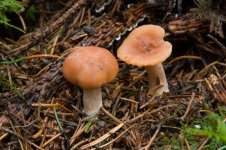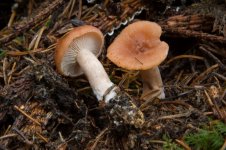Gerry2
Active member
Hi All
Thought I would post a 'LAJ' (Little Apricot Job) for a change. Found this one last week and it has me mystified. It was pure chance that I found it, I was photographing another fungi at the time and in the process of moving a fairly large pine branch to make room for the tripod uncovered this robust little gem.
The habitat was at the edge of an area of conifers situated at the perimeter of a Beech wood, with a thick carpet of moss, it was growing hidden under a decaying fallen or felled pine branch amongst conifer debris.
Any suggestions as to possible genus more than welcome as usual.
Gerry
Details:-
Group of 2.
Cap dia.2cm
Stem ht.2cm
Stem.dia.7mm hollowing.
Flesh- pinkish to pale tan tint, very watery when cut.
Thought I would post a 'LAJ' (Little Apricot Job) for a change. Found this one last week and it has me mystified. It was pure chance that I found it, I was photographing another fungi at the time and in the process of moving a fairly large pine branch to make room for the tripod uncovered this robust little gem.
The habitat was at the edge of an area of conifers situated at the perimeter of a Beech wood, with a thick carpet of moss, it was growing hidden under a decaying fallen or felled pine branch amongst conifer debris.
Any suggestions as to possible genus more than welcome as usual.
Gerry
Details:-
Group of 2.
Cap dia.2cm
Stem ht.2cm
Stem.dia.7mm hollowing.
Flesh- pinkish to pale tan tint, very watery when cut.





